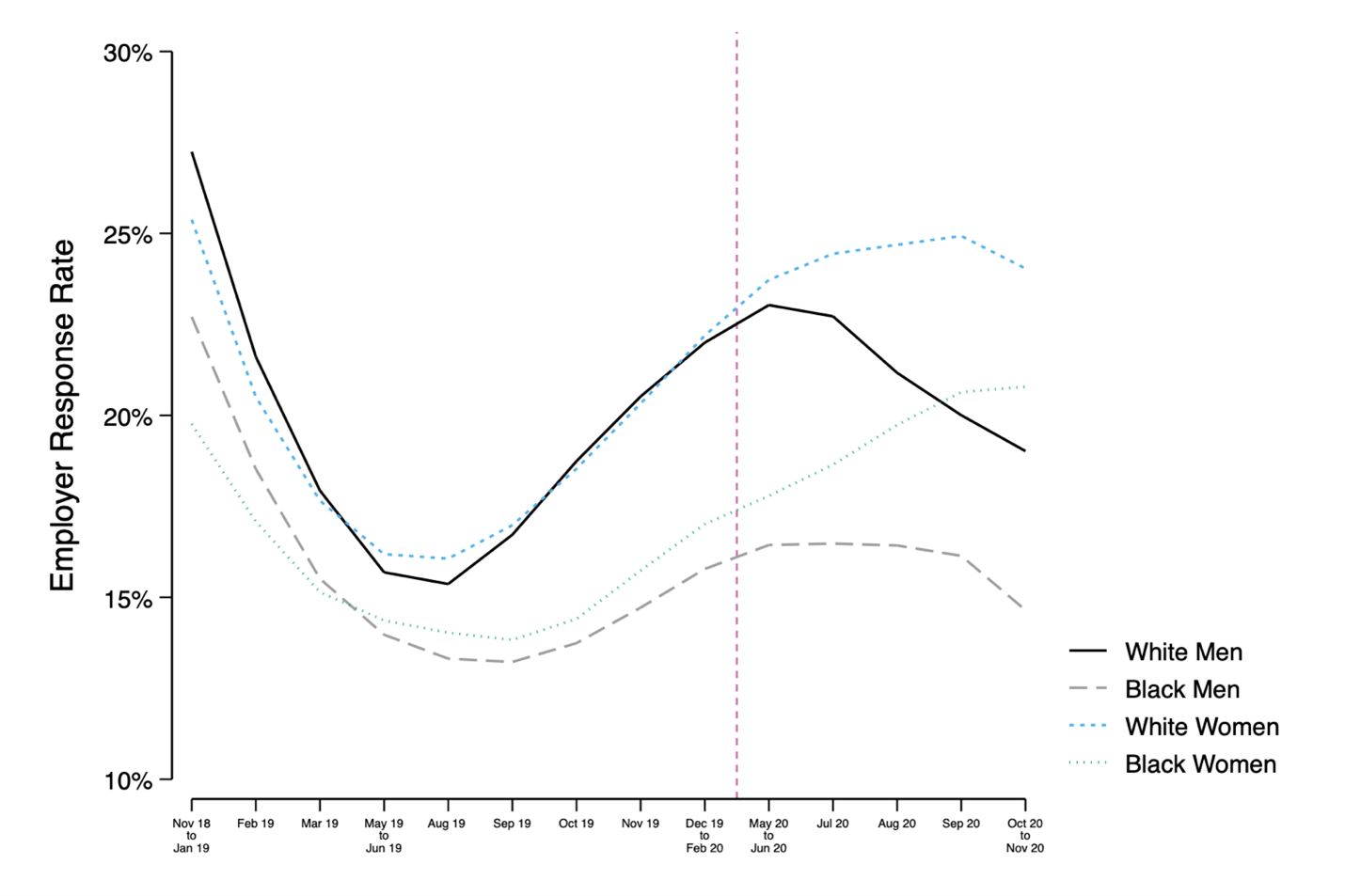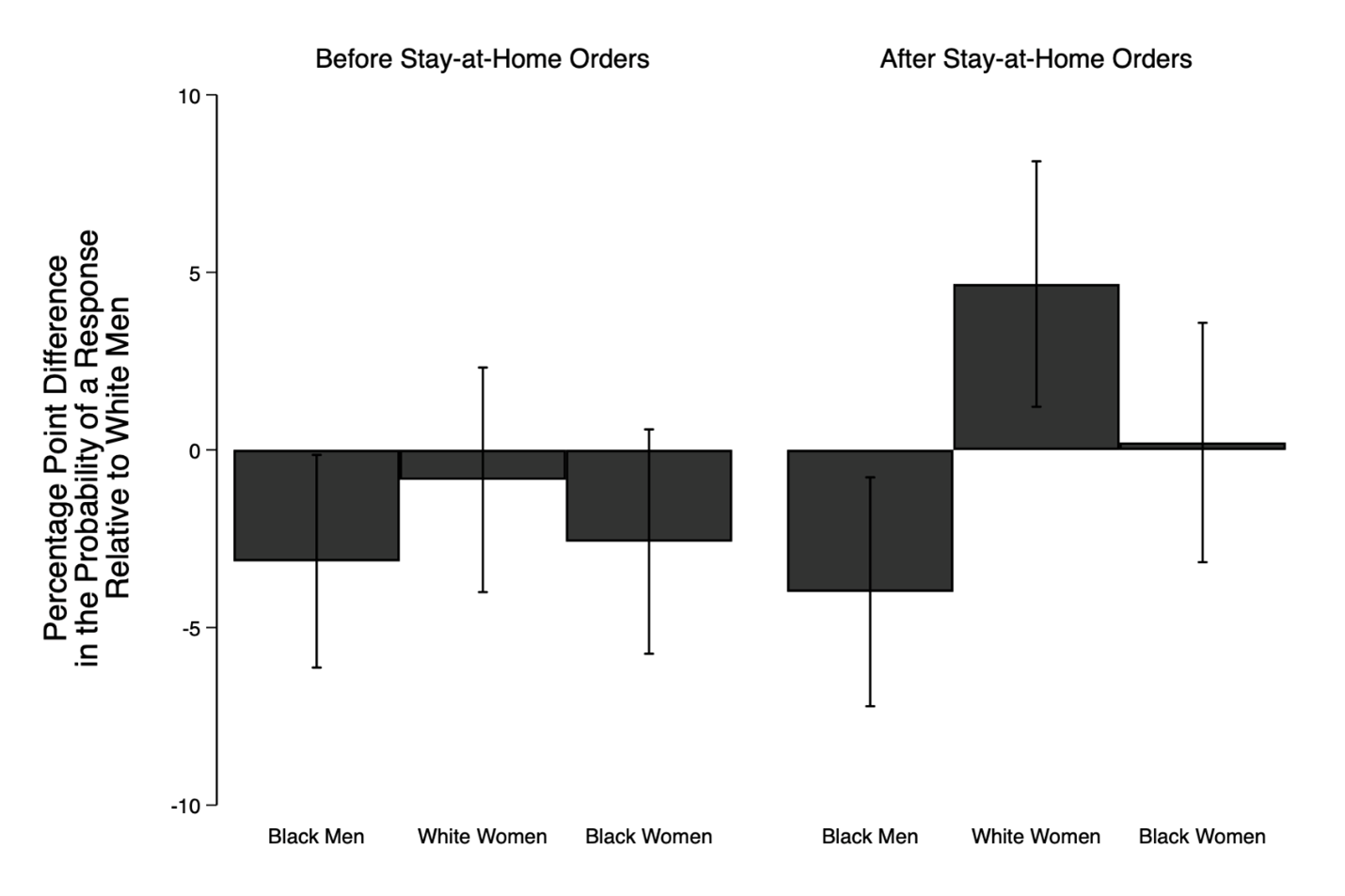The COVID-19 pandemic has completely upended our social and economic lives. Many have left their jobs, and many of those who are still working have reduced their work hours to make up for increasing demands at home.1As the nation slowly recovers from the pandemic, workers enter an economy still devastated by a year of closures and layoffs. How are workers faring in this new world? In particular, how have the barriers facing women and workers of color in the labor market changed, if at all? These are the questions that interest me and my coauthors, Dr. Kate Weisshaar and graduate student Tania Cabello-Hutt. In our ongoing research project, we ask, how have patterns of racial and gender discrimination at the point of hire changed during the COVID-19 pandemic?
Has Racial and Gender Discrimination Changed During the COVID-19 Pandemic?

Key Findings
- Discrimination at the point of hire against Black workers, particularly Black men, remains consistent before and during the COVID-19 pandemic. Specifically, Black men receive about 18% fewer responses from employers than White men regardless of whether they applied before or during the pandemic.
- In contrast, the COVID-19 pandemic has seen an increase in discrimination in favor of White women. Before the pandemic, White women and White men receive a similar number of responses from employers. During the pandemic, White women receive 22% more responses from employers than White men.
How Does the COVID-19 Pandemic Relate to Discrimination at the Point of Hire?
To examine how the COVID-19 pandemic may be related to changes in discrimination patterns, it is first important to understand the pandemic’s impact on workers exiting the labor market. Women, particularly mothers, have disproportionately left their jobs or decreased their work hours during the pandemic in response to increased family and care responsibilities.2 We hypothesize that employers may seek to replace exiting women with other women because they think gender is somehow important for the role. They might also desire their workforce to have a particular gender composition, and exiting women throws off the desired gender balance. Either way, we predict gender discrimination in favor of women, particularly White women, will increase during the pandemic.
We suspect that the pandemic will have a different relationship with racial discrimination at the point of hire. There is relatively less evidence that the pandemic has caused Black workers to disproportionately leave the labor market relative to White workers, especially among college-educated workers.3,4 We predict racial discrimination against Black workers will be consistent before and during the COVID-19 pandemic, given the relatively muted racial disparities in the pandemic’s impact on employment.
Detecting Discrimination
From November 2018 to November 2020, we conducted a correspondence audit study in which we sent fictitious resumes of senior accountants to real job openings for senior accountant positions across the 50 most populous cities in the United States. Our fictitious applicants were either a White man, a Black man, a White woman, or a Black woman, which we signaled by the applicants’ name. To measure discrimination, we recorded the number of responses from employers and whether the number of responses varied by race and gender.
We are interested in whether discrimination differs before and during the COVID-19 pandemic. To mark the substantive beginning of the COVID-19 pandemic, we use the initial wave of state stay-at-home orders issued from March 19, 2020 to April 6, 2020. In those short few weeks, all states except for Arkansas, Iowa, Nebraska, North Dakota, South Dakota, and Wyoming issued some form of stay-at-home orders. We compare discrimination before and after this initial wave of stay-at-home orders to determine how the pandemic has affected discrimination.

Findings
Figure 1 shows the employer response rates for men and women applicants by race over time. Before the pandemic, employer response rates ebb and flow in response to usual changes in demand for senior accountants, but the gender and racial differences in employer response rates remain stable. During the pandemic, employer response rates between women and men diverge:
White and Black women begin to receive more employer responses than White and Black men.
We conduct a more rigorous analysis to nail down the effects of the pandemic on discrimination. We find that discrimination against Black men, relative to White men, has remained stable before and during the COVID-19 pandemic. We do not find evidence of significant discrimination against Black women in either period. The pattern for White women is markedly different: employers are significantly more likely to respond to White women than White men, all else equal, during the pandemic than before.
Figure 2 (below) shows the percentage point difference in the probability of an employer response for Black men, White women, and Black women compared to White men, both before and during the COVID-19 pandemic. A negative value indicates discrimination relative to White men. For Black men, the probability of an employer response is lower than the probability for White men in both time periods – around 3 percentage points lower before the pandemic and 4 percentage points lower during the pandemic. For White women, the probability of an employer response is statistically equal to that of White men before the pandemic, but 4.7 percentage points higher than White men during the pandemic.

What Does this Mean?
Our findings suggest the COVID-19 pandemic has not only upended our social and economic lives, but it has also altered patterns of discrimination at the point of hire—particularly for White women. The pandemic has also revealed the persistence of discrimination against Black men. What remains unclear is whether these changes in discrimination will remain stable once we have fully recovered from the pandemic.
- Pew Research Center. Pew Research Center - "Economic Fallout From COVID-19 Continues to Hit Lower Income Americans..."
- Collins, Caitlyn, Liana Christin Landivar, Leah Ruppanner, and William J. Scarborough. 2020. “COVID-19 and the Gender Gap in Work Hours.” Gender, Work and Organization 1–12.
- Couch, Kenneth A., Robert W. Fairlie, and Huanan Xu. 2020. “Early evidence of the impacts of COVID-19 on minority unemployment.” Journal of Public Economics 192:104287.
- Moen, Phyllis, Joseph H Pedtke, and Sarah Flood. 2020. “Disparate Disruptions: Intersectional COVID-19 Employment Effects by Age, Gender, Education, and Race/Ethnicity.” Work, Aging and Retirement 6:207–228.
Meet the Researcher
Koji Chavez is an Assistant Professor of Sociology at Indiana University and CRRES Fellow. His research focuses on gender and racial discrimination in the labor market and inequality producing processes within organizations.


